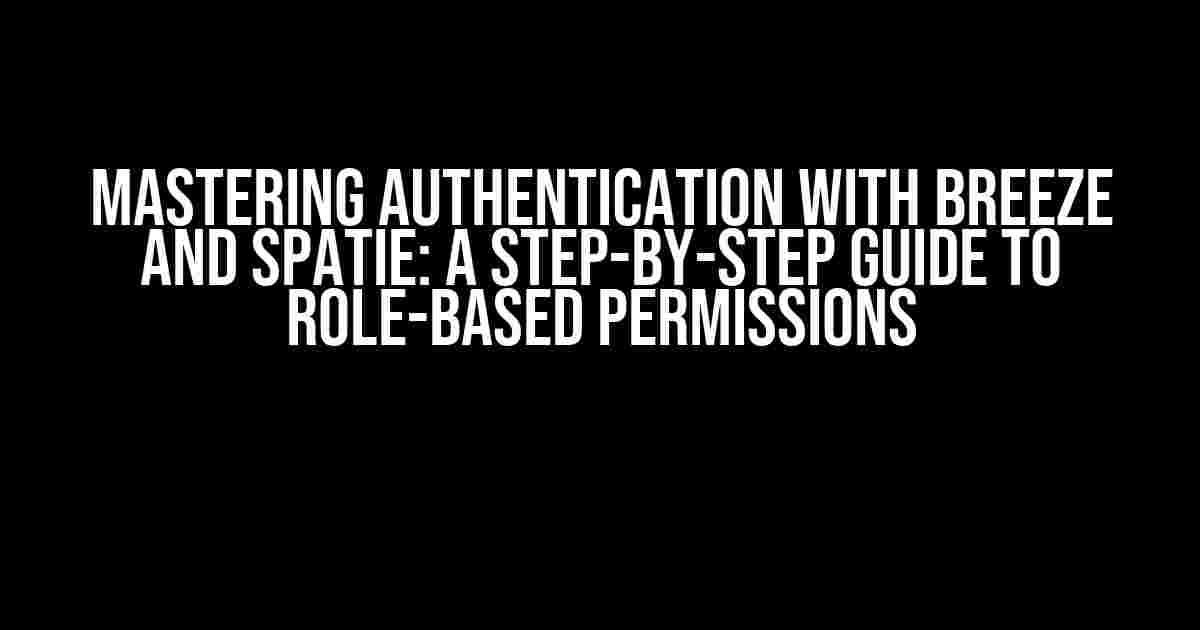In the world of Laravel development, authentication and permission management are crucial aspects of building a secure and scalable application. In this article, we’ll explore how to implement role-based authentication using Breeze and Spatie, two popular Laravel packages. By the end of this tutorial, you’ll have a comprehensive understanding of how to create a robust permission system that’s tailored to your application’s unique needs.
What is Breeze and Spatie?
Breeze is a Laravel package that provides a simple and intuitive way to implement authentication in your application. It’s developed by the Laravel team and is designed to be fast, secure, and easy to use. Spatie, on the other hand, is a separate package that focuses on permission management. It provides a robust and flexible system for managing permissions, roles, and users.
Setting Up the Environment
Before we dive into the implementation, make sure you have the following installed:
- Laravel 8.x or higher
- Breeze package ( installing via composer: `composer require laravel/breeze`)
- Spatie package (installing via composer: `composer require spatie/laravel-permission`)
Configuring Breeze
First, let’s set up Breeze to handle authentication in our application. Run the following command in your terminal:
php artisan breeze:installThis command will install the necessary files and configurations for Breeze. Next, publish the config file using:
php artisan vendor:publish --tag=breeze-configOpen the `config/breeze.php` file and update the `guards` section to use the `web` guard:
'guards' => [
'web' => [
'driver' => 'session',
'provider' => null,
],
],
Implementing Role-Based Authentication with Breeze
Now that Breeze is configured, let’s create a role-based authentication system. We’ll create three roles: `admin`, `moderator`, and `user`. Create a new migration file using:
php artisan make:migration create_roles_tableIn the migration file, add the following code:
public function up()
{
Schema::create('roles', function (Blueprint $table) {
$table->id();
$table->string('name');
$table->string('description');
$table->timestamps();
});
}
Run the migration using:
php artisan migrateNext, create a new seeder file using:
php artisan make:seeder RoleSeederIn the seeder file, add the following code:
public function run()
{
DB::table('roles')->insert([
['name' => 'admin', 'description' => 'Administrator role'],
['name' => 'moderator', 'description' => 'Moderator role'],
['name' => 'user', 'description' => 'User role'],
]);
}
Run the seeder using:
php artisan db:seed --class=RoleSeederIntegrating Spatie for Permission Management
Now that we have our roles set up, let’s integrate Spatie to handle permission management. First, publish the Spatie config file using:
php artisan vendor:publish --tag=laravel-permission-configOpen the `config/laravel-permission.php` file and update the `models` section to use the `App\Models\User` model:
'models' => [
'permission' => App\Models\Permission::class,
'role' => App\Models\Role::class,
],
Defining Permissions
Create a new migration file using:
php artisan make:migration create_permissions_tableIn the migration file, add the following code:
public function up()
{
Schema::create('permissions', function (Blueprint $table) {
$table->id();
$table->string('name');
$table->string('description');
$table->timestamps();
});
}
Run the migration using:
php artisan migrateNext, create a new seeder file using:
php artisan make:seeder PermissionSeederIn the seeder file, add the following code:
public function run()
{
DB::table('permissions')->insert([
['name' => 'view_dashboard', 'description' => 'View dashboard'],
['name' => 'manage_users', 'description' => 'Manage users'],
['name' => 'edit_articles', 'description' => 'Edit articles'],
]);
}
Run the seeder using:
php artisan db:seed --class=PermissionSeederAssigning Permissions to Roles
Now that we have our permissions set up, let’s assign them to our roles. Create a new seeder file using:
php artisan make:seeder RolePermissionSeederIn the seeder file, add the following code:
public function run()
{
$adminRole = App\Models\Role::where('name', 'admin')->first();
$moderatorRole = App\Models\Role::where('name', 'moderator')->first();
$userRole = App\Models\Role::where('name', 'user')->first();
$viewDashboardPermission = App\Models\Permission::where('name', 'view_dashboard')->first();
$manageUsersPermission = App\Models\Permission::where('name', 'manage_users')->first();
$editArticlesPermission = App\Models\Permission::where('name', 'edit_articles')->first();
$adminRole->givePermissionTo($viewDashboardPermission);
$adminRole->givePermissionTo($manageUsersPermission);
$adminRole->givePermissionTo($editArticlesPermission);
$moderatorRole->givePermissionTo($viewDashboardPermission);
$moderatorRole->givePermissionTo($editArticlesPermission);
$userRole->givePermissionTo($viewDashboardPermission);
}
Run the seeder using:
php artisan db:seed --class=RolePermissionSeederUsing Breeze and Spatie in Your Application
Now that we have our role-based authentication and permission system set up, let’s use it in our application. Create a new middleware file using:
php artisan make:middleware CheckPermissionIn the middleware file, add the following code:
public function handle(Request $request, Closure $next)
{
$role = auth()->user()->role;
$permission = $request->route()->getName();
if (!$role->hasPermissionTo($permission)) {
abort(403);
}
return $next($request);
}
Register the middleware in the `kernel.php` file:
protected $middleware = [
// ...
\App\Http\Middleware\CheckPermission::class,
];
Now, when a user tries to access a route, the middleware will check if they have the required permission. If they don’t, a 403 error will be thrown.
Conclusion
In this article, we’ve covered how to implement role-based authentication with Breeze and permission management with Spatie. By following these steps, you can create a robust and scalable permission system that’s tailored to your application’s unique needs. Remember to always follow best practices and security guidelines when implementing authentication and permission systems in your application.
| Package | Description |
|---|---|
| Breeze | Laravel package for authentication |
| Spatie | Laravel package for permission management |
By mastering Breeze and Spatie, you can take your Laravel application to the next level and build a secure and scalable permission system that meets your users’ needs.
- Set up Breeze for authentication
- Implement role-based authentication with Breeze
- Integrate Spatie for permission management
- Define permissions and assign them to roles
- Use Breeze and Spatie in your application
Frequently Asked Questions
Get the scoop on authenticating with Breeze based on roles and using Spatie for handling permissions!
What is Breeze, and how does it help with authentication?
Breeze is a lightweight and convenient package for Laravel that provides a simple and easy-to-use authentication system. It helps with authentication by providing a simple way to manage user sessions, login, and registration. With Breeze, you can create a robust authentication system without the complexity of Laravel’s built-in authentication system.
How do I set up role-based authentication with Breeze?
To set up role-based authentication with Breeze, you’ll need to create a `roles` table in your database and define the roles in your `User` model. Then, you can use middleware to check the user’s role and redirect them to the appropriate route. For example, you can create a `RoleMiddleware` that checks if the user has a specific role before allowing them to access a certain route.
What is Spatie, and how does it help with permission handling?
Spatie is a popular Laravel package that provides a simple and efficient way to handle permissions and roles. It allows you to define permissions and assign them to users or roles, making it easy to manage access control in your application. With Spatie, you can create a robust permission system that integrates seamlessly with Breeze’s authentication system.
How do I integrate Spatie with Breeze for role-based authentication?
To integrate Spatie with Breeze, you’ll need to install both packages and configure them to work together. You can use Spatie’s permission system to define roles and permissions, and then use Breeze’s authentication system to check the user’s role and grant access to specific routes. For example, you can create a middleware that checks if the user has a specific permission before allowing them to access a certain route.
What are some best practices for implementing role-based authentication with Breeze and Spatie?
Some best practices for implementing role-based authentication with Breeze and Spatie include defining clear and concise roles and permissions, using middleware to check permissions, and implementing a robust access control system. Additionally, make sure to follow Laravel’s and Spatie’s documentation to ensure you’re using the packages correctly and efficiently.




